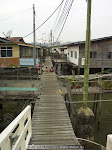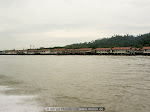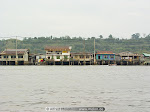Compare and contrast living in a village with living in a city
In England, I live in a small town, while here in Abu Dhabi I live in a large, modern city. So I’m well qualified to compare and contrast village and city life.
There are certain similarities between the two lifestyles. Firstly, in both villages and towns you find domestic residences. Roads, schools, hospitals, shops, garages, and so on, are also common to both village and city.
The main difference between village and city is, of course, in terms of size and number. In a small village, there might be only one shop, one school, one garage, one hospital or clinic. In a large city, there are many of each. In addition a village shop will likely be small, whereas in a city like Abu Dhabi we have many large-scale shopping malls, in addition to supermarkets and smaller shops. Similarly, in a large city there will be more, and bigger, schools, hospitals and garages.
Personally, I love living in a small, quiet rural town when I’m in England. I savour walking in the countryside and along the coast. I relish the clean environment. I like using the local fishmonger, baker and other town tradespeople. On the other hand, I enjoy the wider range of shops, restaurants and sporting facilities here in Abu Dhabi. The increased noise and pollution is the price I pay for this.
223 words.
Tuesday, December 15, 2009
How a student joins ADMC
Not everyone can join ADMC. There is a specific procedure which must be followed and this is it.
Firstly, all prospective students are given the CEPA test, in both English and mathematics. The papers from the test are then marked by teachers from the Higher Colleges of Technology. After being marked, the results are sent to the Ministry of Education. Based on school results and the CEPA test, successful students are enrolled into the college. The students are then registered into Diploma or Higher Diploma courses. After that, ID cards and parking permits are issued to the newly-registered students; photos are needed for this part of the process. Each student is then assigned to a section and given a timetable. Details of the timetable, teachers and room numbers are checked by the students.
As you can see, joining ADMC is a long process. When he has completed the above steps, the new student is ready to start learning at his new college.
167 words.
Not everyone can join ADMC. There is a specific procedure which must be followed and this is it.
Firstly, all prospective students are given the CEPA test, in both English and mathematics. The papers from the test are then marked by teachers from the Higher Colleges of Technology. After being marked, the results are sent to the Ministry of Education. Based on school results and the CEPA test, successful students are enrolled into the college. The students are then registered into Diploma or Higher Diploma courses. After that, ID cards and parking permits are issued to the newly-registered students; photos are needed for this part of the process. Each student is then assigned to a section and given a timetable. Details of the timetable, teachers and room numbers are checked by the students.
As you can see, joining ADMC is a long process. When he has completed the above steps, the new student is ready to start learning at his new college.
167 words.
Sunday, December 13, 2009
How olive oil is made
Producing olive oil is a fairly long and difficult process but if you follow these steps you should end up with good quality oil.
First, between September and December, the olives are harvested by hand or with sticks and rakes. Then they are collected on nets beneath the trees. After that, leaves and small stones are removed and the olives are run through a washer to remove any impurities before crushing. Then, within 24-36 hours of picking, the olives are crushed by granite millstones. The olive paste obtained is layered on mats which are put under pressure from a screw or hydraulic press. The liquid produced is collected and put through a centrifugal separator to separate the water and impurities from the oil. Finally, after centrifugation, the oil is obtained.
Superior olive oil is opaque and amber in colour. The less acidic the oil, the better the quality.
153 words.
Wednesday, December 9, 2009
Reflection 4
Reflection 4
Compare & contrast essays should consist of:
(a) a brief introduction saying which two things you are going to compare (similarities) & contrast (differences).
(b) a paragraph in which you discuss similarities i.e. the most obvious similarity is ... another similarity is ... yet another similarity is ... There should be at least 3 or 4 similarities.
(c) a paragraph in which you discuss differences. Again there should be at least 3 or 4.
(d) a conclusion in which you state some kind of preference for one over the other. It doesn't have to be black & white i.e. one is good and the other is bad. You can be positive about both things: see my essay on Brunei & the UAE.
Compare & contrast essays should consist of:
(a) a brief introduction saying which two things you are going to compare (similarities) & contrast (differences).
(b) a paragraph in which you discuss similarities i.e. the most obvious similarity is ... another similarity is ... yet another similarity is ... There should be at least 3 or 4 similarities.
(c) a paragraph in which you discuss differences. Again there should be at least 3 or 4.
(d) a conclusion in which you state some kind of preference for one over the other. It doesn't have to be black & white i.e. one is good and the other is bad. You can be positive about both things: see my essay on Brunei & the UAE.
Brunei & the UAE
In this essay I am going to compare and contrast two countries, Brunei and the UAE.
Firstly, let us examine the similarities. Both are Islamic countries and both have hereditary monarchies. In addition, both countries are very rich because of large-scale natural resources of oil and gas. Furthermore, both countries have national airlines, modern airports and well-developed infrastructures.
There are, however, a number of differences. First and most obvious is geographical location. The UAE is in the Middle East whereas Brunei is a tropical country in the Far East. Another difference is climate. The UAE has winter and summer, but in Brunei the weather is largely the same all year round. It also rains a lot more in Brunei and, as a result, the tradition is to build houses on stilts. Another difference is the currency, dirhams in the UAE and ringgits in Brunei. Furthermore, people drive on the right in the UAE but on the left in Brunei. Secondary education is single-sex in the UAE but co-educational in Brunei. A final difference is dress; people in Brunei do not wear dishdashas or ubayas.
I've worked happily in both countries and both are safe, pleasant places to work and raise families in. Brunei was more exciting in that it was my first overseas post but here in the UAE right now I'm very comfortable, both professionally and socially.
228 words
Firstly, let us examine the similarities. Both are Islamic countries and both have hereditary monarchies. In addition, both countries are very rich because of large-scale natural resources of oil and gas. Furthermore, both countries have national airlines, modern airports and well-developed infrastructures.
There are, however, a number of differences. First and most obvious is geographical location. The UAE is in the Middle East whereas Brunei is a tropical country in the Far East. Another difference is climate. The UAE has winter and summer, but in Brunei the weather is largely the same all year round. It also rains a lot more in Brunei and, as a result, the tradition is to build houses on stilts. Another difference is the currency, dirhams in the UAE and ringgits in Brunei. Furthermore, people drive on the right in the UAE but on the left in Brunei. Secondary education is single-sex in the UAE but co-educational in Brunei. A final difference is dress; people in Brunei do not wear dishdashas or ubayas.
I've worked happily in both countries and both are safe, pleasant places to work and raise families in. Brunei was more exciting in that it was my first overseas post but here in the UAE right now I'm very comfortable, both professionally and socially.
228 words
Sunday, December 6, 2009
Reflection 3
Reflection 3
When teaching process essays, I point out that very often the task, in the assignment or progress test, will specify the use of the passive.
Basically, process essays involve the present passive, usually is/are with the past participle.It's important to point out that with some verbs the simple past & past participle are the same, but with other verbs there are 2 separate forms, e.g. go, went & gone.
The essay structure is similar to procedure, i.e. intro (c. 25-30 words); main paragraph (c. 100 words); conclusion (c. 25-30 words). Total: 150-160 words.The same linking words can be used: first, secondly, next, after that, finally.
In the model essays I post in my blog I usually colour code in order to show present passives, other passives and linking words.
When teaching process essays, I point out that very often the task, in the assignment or progress test, will specify the use of the passive.
Basically, process essays involve the present passive, usually is/are with the past participle.It's important to point out that with some verbs the simple past & past participle are the same, but with other verbs there are 2 separate forms, e.g. go, went & gone.
The essay structure is similar to procedure, i.e. intro (c. 25-30 words); main paragraph (c. 100 words); conclusion (c. 25-30 words). Total: 150-160 words.The same linking words can be used: first, secondly, next, after that, finally.
In the model essays I post in my blog I usually colour code in order to show present passives, other passives and linking words.
Subscribe to:
Comments (Atom)









.jpg)
.jpg)
.jpg)




.jpg)

